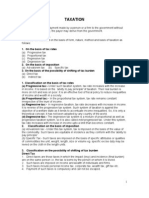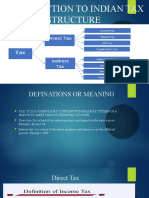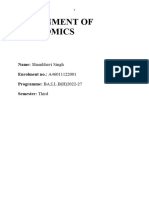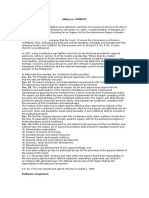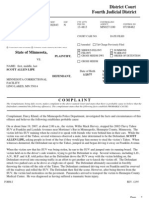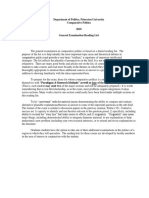Assignment On: Public Finance For Bangladesh Perspective
Assignment On: Public Finance For Bangladesh Perspective
Uploaded by
Nazib UllahCopyright:
Available Formats
Assignment On: Public Finance For Bangladesh Perspective
Assignment On: Public Finance For Bangladesh Perspective
Uploaded by
Nazib UllahOriginal Title
Copyright
Available Formats
Share this document
Did you find this document useful?
Is this content inappropriate?
Copyright:
Available Formats
Assignment On: Public Finance For Bangladesh Perspective
Assignment On: Public Finance For Bangladesh Perspective
Uploaded by
Nazib UllahCopyright:
Available Formats
Assignment on
Public Finance for Bangladesh Perspective
Course name: Laws and Practices of Taxation I (2202)
SUBMITTED TO: Mohammad Moniruzzaman; Chartered Accountant Lecturer Department of Accounting & Information Systems Faculty of Business Studies University of Dhaka SUBMITTED BY: Md. Nazib Ullah ID- 16071; Section- A BBA 16th Batch
Department of Accounting & Information Systems
Faculty of Business Studies University of Dhaka Date of Submission: November 1, 2011
Question1: What should be our tax system? Answer: It is not an easy task to introduce an optimum Tax Structure in an economy. There is an inevitable conflict between defined policies and the ability to execute them. Various characteristics and institutions of an economy may come in the way of adopting an ideal system such as the paucity of data; level of education, cultural patterns etc. but a tax system has to be politically acceptable in conformity with administrative capabilities of authorities. Moreover, several taxes tend to work at cross purposes. An equitable and progressive tax system is likely to be a distinctive for saving and capital accumulation. According to the canons provided by Adam Smith (Wealth of Nation) our Tax System/ Structure should be: Canon of Equality Designing and applying forceful and efficient strategies to deal with noncompliance. Freeze/ takeover of bank accounts of tax defaulters. Modernizing the VAT Law and Rules to reflect international best practices. Assuring strong control of the largest taxpayers, in a dedicated office (and with specialized units for the most critical sectors), as a key step towards introducing risk assessment and fuller taxpayer segmentation. Implementing policies and procedures that limit opportunities for rent seeking and help identify and punish inappropriate behavior in the revenue administration. Canon of Certainty Establishing effective revenue administrations making proper use of withholding and third-party information, and capable of building on these to implement voluntary compliance and self-assessmenttaxpayers calculating and remitting tax themselves, subject to audit and penaltiesboth as a prerequisite for expanding the tax base and to help address corruption. Ensuring that laws and regulations are reasonably simple, readily available, and coherent across taxes, and provide good taxpayer protection (including effective appeals procedures).
Replacing inefficient production or sales taxes, after adequate preparation of both the administration and taxpayers, by a simple VATincluding catalyzing administrative reforms. Canon of Convenience Reestablishing the input credit mechanism through all points/levels of sale to ensure: Avoidance of cascading (tax on tax) effect. Encourage broadening of horizontal integration. Enhance documentation through built-in the incentive mechanism, and improve tax compliance. Simplifying the negative list for goods and services and phasing out avoidable exemptions. Developing tax culture and improving tax compliance. This will entail: Processing of tax returns within a week to identify the non-filers, stop-filers, and irregular filers. At the moment all focus is an account current and tax returns are not even examined and there is no regular follow up based on returns. Sending out automatic computer generated official notices to the registered taxpayers who did not file for the month. Processing of returns for internal consistency and against certain industry specific tax incidence criteria. Present system of account current will be replaced by return based tax payment. This will entail: No advanced payment of VAT before clearing the goods from factories or services rendered. Taxes will be paid only once a month along with the submission of tax return. Shipment of goods however will be accompanied by shipping documents, and in the event of sale also with sales invoices. In addition to treasury chalans, payments can be made through: a. Certified checks b. Wire transfers from the registered persons bank accounts c. Credit cards and other electronic means. Input tax credit and tax refund will be greatly simplified in the interest of taxpayers and exporters:
Taxpayers will be able to deduct input tax credit themselves based on valid invoices. Tax obligations against domestic sales may be offset against export related refunds. Export refunds would be based on actual taxes paid on inputs, supported by documents. Canon of Economy Avoiding exemptionsunder all taxesthat jeopardize revenue and good governance, are hard to reverse, and generate no clearly offsetting social benefit. Removing minor taxes and fees that are inordinately costly to comply with and administer. Canon of Productivity Extending the coverage of the PIT (particularly through inclusion of smaller businesses and professionals) and establishing coherent taxation of capital income, with an effective rate structure consistent with the authorities distributional preferences. Exploiting the potential for regional cooperation, in both policy and administration particularly on business taxation and excisesto limit mutually damaging competition. Balancing royalties, auctioning and profit-related charges in taxing natural resources. Canon of Buoyancy Administrative efficiency through increased dependence on IT will be the key to revenue generation and relief for taxpayers. Canon of Flexibility Return forms will be reviewed and simplified, as appropriate. Broad-based use of invoices will bring flexibility. Canon of Simplicity Simplifying the procedures for tax compliance, including payment of taxes, maintenance of accounts, submission of returns, and registration of taxpayers.
VAT registration may be given through a single unified electronic registration system. Persons engaged in taxable activities should be able to register electronically. Returns may be submitted electronically as well as by mail to processing centers. Persons may also drop their returns at the drop box in VAT offices. Non-filers will be notified through computer generated letters sent by mail and e-mails. Preliminary return processing may be done centrally at processing centers based on standardized criteria. Building CITs that are simple (in their depreciation and carry forward provisions, for instance) and sufficiently broad-based to allow statutory rates competitive by international standards, with effective tax rates that are reasonably low and uniform across investments. Adopting modern accounts based tax administration and minimizing ad-hoc interactions leading to difficulties for taxpayers. Settle audit disputes. Bilateral meeting with the aim of settling outstanding income taxes. Strengthen monitoring mechanism with a view to ensure deposit of withholding tax and outstanding income tax. Strengthen legal initiatives to end large-revenue related disputes and appealed legal cases in the higher courts of law. Retrieve household asset holding number from municipality and trade-license related information of businesses and thus identify new tax payers. Identify forged TIN (Tax Identification Number). Regular visit in order to coordinate the works of field level offices. Establish tax offices at district level. Create tax related database.
Question: what should be objective of TAX for our country? Answer: Our country, Bangladesh, being a developing country, faces a number of problems connected with economic growth on the one hand and removal of poverty and inequalities on the other. In this case, the primary objectives of TAX are not related to instability of income and employment. In our country, we have the additional problems of chronic unemployment and regional disparities also.
The above considerations enable us to lay down certain objectives of the tax policy which the government, through National Board of Revenue (NBR) should try to pursue for our total development. The objectives are: 1. We must try to come out of our vicious circle of poverty. In this regard, our TAX system must be designed in such a way that the collected TAX revenue will be invested for more industries, create employment. 2. Should promote specific products to fill both the supply and demand gap which will ultimately create savings and capital accumulation. 3. Need to exempt TAX from the agricultural products irrespective of divisions. 4. Should impose higher TAX on unnecessary import. 5. Must promote import substitution and exports by providing TAX incentive. 6. Impose higher tax on unnecessary and conspicuous private consumption to increase TAX revenue. 7. The TAX coverage will have to be increased in both direct and indirect TAX. 8. In order to serve the objective of equity, luxuries and articles of conspicuous consumption should be taxed heavily. 9. Necessities should generally be spared and some articles of mass consumption may be taxed only at low rates. 10. To ensure the equity and resource mobilization, TAX burden should be evenly distributed as between sectors and as between individuals. 11. Encouraging investment in backward regions of the economy. 12. Encourage import substitution and export promotion to overcome balance of payments difficulties. 13. TAX system should be simple, with a few and low rates, and with minimum exemption and rebates. 14. Must rely heavily on indirect TAX such as Value Added Tax for collecting adequate revenue.
You might also like
- Module in Public Policy and Program AdministrationDocument73 pagesModule in Public Policy and Program AdministrationRommel Rios Regala100% (22)
- Solution Review QuestionsDocument41 pagesSolution Review Questionsying huiNo ratings yet
- Botswana Tax Lecture Slides, SydneyDocument84 pagesBotswana Tax Lecture Slides, Sydneysmedupe100% (1)
- Lesson 1 Tax Planning & ManagementDocument35 pagesLesson 1 Tax Planning & ManagementkelvinNo ratings yet
- Key Words: Perceptions Challenges Presumptive Taxation Category C' Tax PayersDocument18 pagesKey Words: Perceptions Challenges Presumptive Taxation Category C' Tax Payersmubarek oumerNo ratings yet
- People vs. Chingh - GR No. 178323 - DigestDocument1 pagePeople vs. Chingh - GR No. 178323 - DigestAbigail Tolabing67% (3)
- Case Digest - Molina FFDocument4 pagesCase Digest - Molina FFRichard BalaisNo ratings yet
- 09 Women and Child WelfareDocument15 pages09 Women and Child WelfareLily Sharma100% (2)
- Taxation Assignment BcaDocument12 pagesTaxation Assignment BcaJeniffer TracyNo ratings yet
- Data For Tax PromotionDocument8 pagesData For Tax PromotionUsama HafeezNo ratings yet
- Taxation Principles and PracticesDocument16 pagesTaxation Principles and PracticesAmira NajjarNo ratings yet
- Chapter 9Document19 pagesChapter 9Nigussie BerhanuNo ratings yet
- An Evaluation of The Tax System in BangladeshDocument7 pagesAn Evaluation of The Tax System in Bangladeshdaveharrison801No ratings yet
- Presumptive Tax 2Document7 pagesPresumptive Tax 2sedrickokello95No ratings yet
- Taxation AssignmentDocument7 pagesTaxation AssignmentBetsy SeyoumNo ratings yet
- Lecture 2 - Tax Administration 1-1Document64 pagesLecture 2 - Tax Administration 1-1Ekua Baduwaa KyeraaNo ratings yet
- Taxation AssignmentDocument5 pagesTaxation Assignmentnareshkharol35No ratings yet
- Recommendations For Tax ReformsDocument2 pagesRecommendations For Tax ReformsSajjad Ahmed SialNo ratings yet
- Chapter 1. Basic Concepts of TaxationDocument7 pagesChapter 1. Basic Concepts of TaxationHafiz Aliyan JahangirNo ratings yet
- System of Taxation in Pakistan: Chapter # 1Document12 pagesSystem of Taxation in Pakistan: Chapter # 1dua tanveerNo ratings yet
- Tax Reforms in PakistanDocument53 pagesTax Reforms in PakistanMübashir Khan100% (2)
- Simply Cleaning: Taxation IssuesDocument10 pagesSimply Cleaning: Taxation IssuesadeelmuzaffaralamNo ratings yet
- Cap 1.2.5Document45 pagesCap 1.2.5DavidNo ratings yet
- Thesis TaxationDocument8 pagesThesis Taxationgjgm36vk100% (2)
- Value Added Tax (VAT)Document4 pagesValue Added Tax (VAT)Rifat HasanNo ratings yet
- Taxation: (A) Ad-Valorem Tax:-Under This Tax System, Tax Is Imposed On The Basis of The Value ofDocument7 pagesTaxation: (A) Ad-Valorem Tax:-Under This Tax System, Tax Is Imposed On The Basis of The Value ofAmbalika SmitiNo ratings yet
- Introduction To Indian Tax StructureDocument45 pagesIntroduction To Indian Tax StructureSadir AlamNo ratings yet
- Advanced Taxation & Fiscal Policy Nov 2011Document7 pagesAdvanced Taxation & Fiscal Policy Nov 2011Samuel DwumfourNo ratings yet
- The Core of Future Tax ReformDocument4 pagesThe Core of Future Tax ReformAnonymous Q8c4ljfZOCNo ratings yet
- ProposalDocument9 pagesProposalDùķe HPNo ratings yet
- Taxn 3100 Instructional Module 1 PDFDocument5 pagesTaxn 3100 Instructional Module 1 PDFSandyNo ratings yet
- Income Tax Self Assessment Scheme Effectiveness andDocument4 pagesIncome Tax Self Assessment Scheme Effectiveness andIrfan AbbasiNo ratings yet
- Tax ManualDocument72 pagesTax ManualOrassa15No ratings yet
- Assignment O2 TaxDocument10 pagesAssignment O2 Taxayushiisingh2002No ratings yet
- Taxation in Sri LankaDocument11 pagesTaxation in Sri LankaThiluneluNo ratings yet
- Self Assessments SchemeDocument10 pagesSelf Assessments SchemeRafae ShahidNo ratings yet
- Taxation Group WorkDocument7 pagesTaxation Group WorkNdam CalsonNo ratings yet
- Taxation: Concept, Nature and Characteristics of Taxation and TaxesDocument11 pagesTaxation: Concept, Nature and Characteristics of Taxation and TaxesMohammad FaizanNo ratings yet
- Lecture Two - Tax Administration 1Document21 pagesLecture Two - Tax Administration 11suave.rico69No ratings yet
- Tax Management: Planning and ComplianceDocument12 pagesTax Management: Planning and ComplianceNidheesh TpNo ratings yet
- GST Assignment Bba Vi SemDocument3 pagesGST Assignment Bba Vi Sem13108imranNo ratings yet
- Tax Planning, Evasion, AvoidanceDocument16 pagesTax Planning, Evasion, AvoidanceDr. Nathan WafNo ratings yet
- Tax Manual KichantaDocument73 pagesTax Manual KichantaInnocent MollaNo ratings yet
- Uganda Management InstituteDocument6 pagesUganda Management InstitutekitstonNo ratings yet
- TAD CH.2 PritDocument76 pagesTAD CH.2 PritYitera SisayNo ratings yet
- Ch. 1Document12 pagesCh. 1sabborarshNo ratings yet
- Tax Effort Assignment-1Document7 pagesTax Effort Assignment-1Abigal MakwecheNo ratings yet
- Tax LawDocument3 pagesTax Lawbanerjee97481No ratings yet
- The Master Note (Law of Taxation) (Covering Important Questions & Answers)Document55 pagesThe Master Note (Law of Taxation) (Covering Important Questions & Answers)HarryNo ratings yet
- Why VATDocument10 pagesWhy VATapi-3822396No ratings yet
- Taxation Note BDDocument4 pagesTaxation Note BDfahadrana206No ratings yet
- Improving Revenue Conservation SkillsDocument24 pagesImproving Revenue Conservation Skillso.onyeanakweNo ratings yet
- Chapter 1. OverviewDocument38 pagesChapter 1. OverviewKhuất Thanh HuếNo ratings yet
- Topic 2 Value Added TaxDocument22 pagesTopic 2 Value Added TaxSam ClassicNo ratings yet
- GST Project PDFDocument47 pagesGST Project PDFjassi7nishadNo ratings yet
- Tcyonline: The Need of The New MillenniumDocument3 pagesTcyonline: The Need of The New MillenniumBharat SharmaNo ratings yet
- HIST11-Group1Document5 pagesHIST11-Group1RESEARCH GROUP 10No ratings yet
- Slide C1-C4Document229 pagesSlide C1-C4Lê Hồng ThuỷNo ratings yet
- Final Exam ACCT 300 - Hiba RafiDocument4 pagesFinal Exam ACCT 300 - Hiba RafiHiba RafiNo ratings yet
- Advanced Tax Presentation GRP 7Document5 pagesAdvanced Tax Presentation GRP 7Goremushandu MungarevaniNo ratings yet
- tax- surumiDocument4 pagestax- surumijessicamalakia777No ratings yet
- Adv PF & TXN Chapter VDocument20 pagesAdv PF & TXN Chapter VSamrawit AndualemNo ratings yet
- Goods and Services TaxDocument6 pagesGoods and Services TaxHARSHULNo ratings yet
- Article Edu ClassificationDocument4 pagesArticle Edu ClassificationKaustubh BajpayeeNo ratings yet
- Governor Generals - British IndiaDocument5 pagesGovernor Generals - British IndiaSriSriNo ratings yet
- Rangel-Rubio Et. Al IndictmentDocument37 pagesRangel-Rubio Et. Al Indictmentsavannahnow.comNo ratings yet
- United States v. Jolley, 10th Cir. (2008)Document10 pagesUnited States v. Jolley, 10th Cir. (2008)Scribd Government DocsNo ratings yet
- Talent Management: A Review of Its Dimensions and Loci in Contemporary TimesDocument5 pagesTalent Management: A Review of Its Dimensions and Loci in Contemporary TimesThe IjbmtNo ratings yet
- Correction: The Fourth Pillar of PCJSDocument19 pagesCorrection: The Fourth Pillar of PCJSMariel AlcazarNo ratings yet
- Abbas Vs ComelecDocument3 pagesAbbas Vs ComelecElerlenne LimNo ratings yet
- Election - HumssDocument15 pagesElection - HumssPatricia James EstradaNo ratings yet
- Employment Law Final .Document21 pagesEmployment Law Final .Lala LawkoNo ratings yet
- Section 5 Which Defines The "Scope of Income" Section 6 Which Defines The "The Residential Status" of The PersonDocument8 pagesSection 5 Which Defines The "Scope of Income" Section 6 Which Defines The "The Residential Status" of The PersondipxxxNo ratings yet
- Political Science AssignmentDocument13 pagesPolitical Science AssignmentLavvina ChoudharyNo ratings yet
- Eastern Star Academy, Inc.: LESSON 2: Differentiate The Political IdeologiesDocument13 pagesEastern Star Academy, Inc.: LESSON 2: Differentiate The Political IdeologiesJhener NonesaNo ratings yet
- Principles of Atatürk and History of Turkish Revolution II: Treaty and Its Aftermath: The Peace Treaty and ItsDocument14 pagesPrinciples of Atatürk and History of Turkish Revolution II: Treaty and Its Aftermath: The Peace Treaty and ItsSmaili TotoNo ratings yet
- Remedial Law RianoDocument25 pagesRemedial Law Rianobelly08No ratings yet
- CommonLit - Progressive EraDocument8 pagesCommonLit - Progressive EraAlec BaldwinNo ratings yet
- Jci Philippines Efficiency Award 2017Document8 pagesJci Philippines Efficiency Award 2017Jefrey BatuigasNo ratings yet
- Homicide ComplaintDocument3 pagesHomicide ComplaintMinnesota Public RadioNo ratings yet
- Princeton - Comparative-Politics-Readings-List-2010Document39 pagesPrinceton - Comparative-Politics-Readings-List-2010Sathyanarayanan DNo ratings yet
- Handbook On Barangay LegislationDocument79 pagesHandbook On Barangay LegislationMajoy Asilo MaraatNo ratings yet
- David vs. Fernandez CaseDocument5 pagesDavid vs. Fernandez CaseRose Ann CalanglangNo ratings yet
- AgendaDocument5 pagesAgendaJelena BajićNo ratings yet
- Barangay Empowerment OrdinanceDocument7 pagesBarangay Empowerment OrdinanceMerson Diaz IINo ratings yet
- Chapter 21 AP Euro OutlineDocument5 pagesChapter 21 AP Euro OutlineAndrew TreulichNo ratings yet
- Act 2Document4 pagesAct 2Shine Bausas CalingasanNo ratings yet
- Voter'S Education Awareness PlanDocument3 pagesVoter'S Education Awareness PlanJoshua RomeaNo ratings yet
- Chapter 03Document25 pagesChapter 03Mohamed MadyNo ratings yet

























